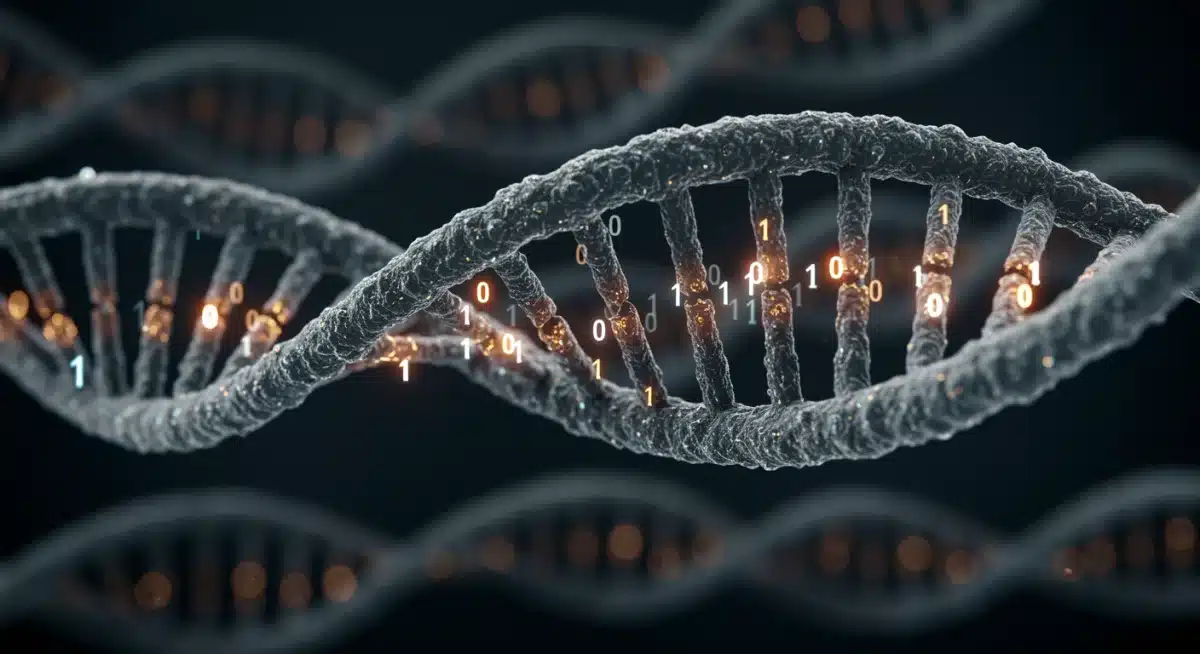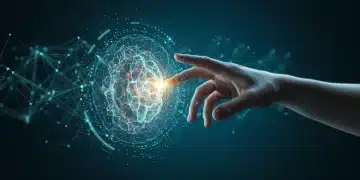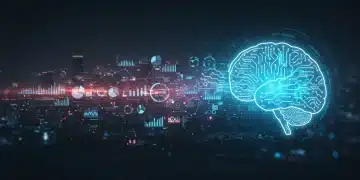Synthetic Biology for Computing: 10x Data Storage by 2030

Recent breakthroughs indicate that Synthetic Biology for Computing: New Data Storage Potential by 2030 with 10x Density is rapidly becoming a reality, heralding a new era for how we store vast amounts of digital information. This emerging field promises to revolutionize data management, offering unprecedented density and longevity compared to traditional methods. Are we on the cusp of a biological data revolution?
The Dawn of DNA Data Storage
The concept of using DNA for data storage has moved from theoretical discussions to tangible advancements in laboratories worldwide. This involves encoding digital information into synthetic DNA sequences, leveraging DNA’s incredible natural density and stability. As of recent reports, researchers are making significant strides in both writing and reading data from DNA, pushing the boundaries of what was once considered science fiction.
The allure of DNA as a storage medium lies in its astonishing information density. A single gram of DNA can theoretically store zettabytes of data, far surpassing the capabilities of any current electronic or magnetic storage solution. This inherent capacity is driving intense research and development, with several startups and academic institutions vying to perfect the technology.
Encoding Digital into Biological
The process of storing data in DNA involves translating binary code (0s and 1s) into the four nucleotide bases of DNA: Adenine (A), Guanine (G), Cytosine (C), and Thymine (T). This conversion creates synthetic DNA strands that physically hold the digital information. The complexity lies in ensuring accurate encoding and later, reliable decoding.
- Sequence Conversion: Digital bits are mapped to DNA bases using specific algorithms. For example, 00 could be A, 01 C, 10 G, and 11 T.
- Synthesis: Custom DNA strands are then chemically synthesized based on these encoded sequences. This is a precise and often slow process, but advancements are accelerating.
- Error Correction: Redundancy and error-correcting codes are integrated into the encoding process to mitigate potential synthesis or sequencing errors.
Unlocking Unprecedented Density and Longevity
The promise of a 10x density increase by 2030 is not merely aspirational; it is grounded in the fundamental properties of DNA itself. Unlike traditional storage media that degrade over decades, DNA can remain stable for thousands, even tens of thousands of years, under the right conditions. This makes it an ideal candidate for archival storage of humanity’s ever-growing digital footprint.
The sheer volume of data generated globally continues to skyrocket, from scientific research and medical records to personal photos and videos. Current data centers consume vast amounts of energy and physical space. DNA storage offers a potential solution to these challenges, providing a compact, durable, and energy-efficient alternative for long-term data preservation.
Challenges in DNA Data Storage Implementation
While the benefits are clear, several hurdles remain before DNA data storage becomes a mainstream reality. The primary challenges revolve around the speed and cost of writing and reading data. Current synthesis and sequencing technologies are still relatively slow and expensive, making them impractical for everyday use.
- Synthesis Speed: Creating custom DNA strands is a time-consuming chemical process, limiting the write speed for large datasets.
- Sequencing Cost: Reading the data back requires DNA sequencing, which, while becoming cheaper, is still more expensive than reading from hard drives.
- Random Access: Retrieving specific data from a pool of DNA strands efficiently remains a complex problem.
Major Players and Recent Advancements
The field of synthetic biology for data storage is buzzing with activity. Leading research institutions and biotech companies are pouring resources into overcoming the technical barriers. As of late, new enzymatic methods for DNA synthesis are showing promise, offering faster and potentially more cost-effective ways to write data onto DNA. These innovations are critical for achieving the projected 10x density by 2030.
Companies like Twist Bioscience are already offering commercial DNA synthesis services, though primarily for research and therapeutic applications. However, their advancements directly contribute to the scalability of DNA data storage. Microsoft has also been a significant player, demonstrating early proof-of-concept systems for storing and retrieving digital files from DNA.

Bridging Synthetic Biology and Computing
The convergence of synthetic biology and traditional computing represents a paradigm shift. It requires interdisciplinary expertise, bringing together molecular biologists, computer scientists, and engineers to develop integrated solutions. This collaboration is essential for designing robust encoding schemes, developing automated synthesis and sequencing platforms, and creating efficient data retrieval mechanisms.
The potential applications extend beyond simple archival storage. Imagine biological computing systems that can process data within living cells, or bio-hybrid devices that combine silicon-based processors with DNA storage. These futuristic concepts are slowly taking shape as researchers gain a deeper understanding of programmable biology.
Interdisciplinary Research Efforts
Success in this domain hinges on strong collaborative efforts. Universities are launching specialized programs that blend biology, computer science, and engineering to train the next generation of innovators. These programs focus on:
- Algorithm Development: Designing more efficient and error-resilient encoding and decoding algorithms for DNA.
- Automated Systems: Creating robotic platforms for high-throughput DNA synthesis and sequencing.
- Bioinformatics Tools: Developing software to manage, index, and retrieve data stored in complex DNA libraries.
Economic and Environmental Impact Projections
The projected increase in data density by 2030 has profound economic and environmental implications. A more compact and durable storage solution could significantly reduce the physical footprint and energy consumption of data centers, leading to substantial cost savings and a lower carbon footprint. This aligns with global efforts towards more sustainable technology.
Furthermore, the long-term stability of DNA storage means data can be preserved for millennia without the need for constant migration to new formats or hardware. This could save billions in maintenance costs over time and ensure the survival of critical historical, scientific, and cultural data. The economic incentive for such a solution is immense, prompting significant investment.
Sustainability and Cost Efficiency
The environmental benefits of DNA storage are a key driver for its development. As data generation continues its exponential growth, the energy demands of traditional storage are becoming unsustainable. DNA offers a passive storage medium that, once written, requires minimal energy for preservation.
The initial costs are high, but as technology matures and scales, the cost per bit stored is expected to dramatically decrease. This follows a similar trajectory to other groundbreaking technologies, such as semiconductor manufacturing, where early high costs are eventually overcome by mass production and innovation.
The Road Ahead: 2030 and Beyond
Achieving a 10x density increase by 2030 for Synthetic Biology for Computing: New Data Storage Potential by 2030 with 10x Density is an ambitious but increasingly plausible goal. The next few years will see continued innovation in enzymatic synthesis, microfluidic platforms for DNA handling, and advanced sequencing technologies. Researchers are also exploring novel ways to integrate DNA storage into existing computing infrastructures, perhaps as a hybrid archival layer.
The focus will likely shift from pure proof-of-concept demonstrations to developing commercially viable, scalable solutions. Standardization efforts will also become crucial to ensure interoperability and long-term accessibility of DNA-stored data. The journey to widespread adoption will be incremental, but the foundational work is being laid now.
Key Milestones for the Next Decade
Several critical advancements are anticipated in the coming years that will pave the way for broader DNA data storage adoption:
- Faster Synthesis: Development of methods to synthesize DNA at rates comparable to modern hard drive write speeds.
- Cheaper Sequencing: Reduction in the cost of DNA sequencing to make data retrieval economically feasible for large archives.
- Automated Systems: Creation of fully automated, ‘dark’ data centers where DNA data is written, stored, and retrieved with minimal human intervention.
- Standardization: Establishing universal protocols for DNA data encoding, storage, and retrieval to ensure long-term compatibility.
| Key Point | Brief Description |
|---|---|
| DNA Data Storage | Encodes digital information into synthetic DNA, leveraging its high density and stability. |
| 10x Density by 2030 | Projected increase in data storage capacity, surpassing traditional methods significantly. |
| Longevity & Sustainability | DNA stores data for millennia, reducing energy consumption and hardware migration needs. |
| Interdisciplinary Field | Combines biology, computer science, and engineering to develop integrated solutions. |
Frequently Asked Questions About DNA Data Storage
Synthetic biology data storage involves encoding digital information into sequences of synthetic DNA. This method leverages DNA’s natural ability to store vast amounts of genetic information in an incredibly compact and durable form, offering a potential solution to the growing global data storage crisis.
Theoretically, one gram of DNA can store multiple zettabytes (a trillion gigabytes) of data. This represents an astonishing density, far exceeding the capacity of current electronic storage devices. This immense storage potential is a key driver for research and development in synthetic biology for computing.
Experts project that by 2030, advancements in synthetic biology could enable a 10x increase in data storage density using DNA-based methods. This is driven by ongoing improvements in DNA synthesis and sequencing technologies, alongside more efficient encoding and retrieval algorithms being developed by researchers globally.
The primary challenges include the high cost and slow speed of writing (synthesizing) and reading (sequencing) DNA. Efficient random access to specific data within large DNA pools also remains a significant hurdle. Researchers are actively working on enzymatic synthesis and microfluidic technologies to overcome these limitations.
DNA data storage is sustainable because DNA can preserve information for thousands of years without power, unlike traditional data centers that require constant energy. This reduces the carbon footprint and eliminates the need for frequent data migration to new hardware, contributing to long-term digital preservation and environmental benefits.
Looking Ahead
The trajectory of Synthetic Biology for Computing: New Data Storage Potential by 2030 with 10x Density suggests a future where our digital archives are not only vast but also incredibly resilient. The ongoing research into faster, cheaper synthesis and sequencing methods, coupled with the development of robust error-correction protocols, will be critical. Watch for continued breakthroughs in automation and the emergence of hybrid storage solutions that could integrate DNA into existing data infrastructure, signaling a profound shift in how we manage the world’s information.





